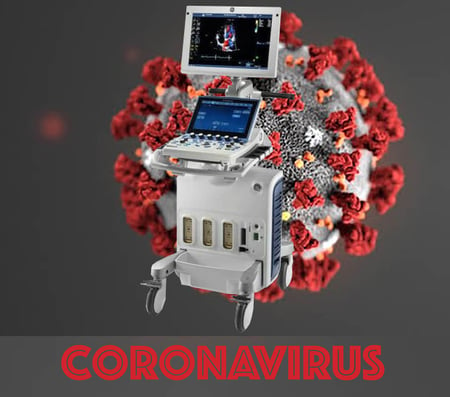Physicians worldwide are looking for tools to help with the diagnosis, treatment and admission  decisions for COVID-19—and sharing their findings.
decisions for COVID-19—and sharing their findings.
For example, Dr. Yale Tung Chen, an emergency medicine physician at an academic hospital in Madrid, Spain recently used point-of-care ultrasound (POCUS) to track his own COVID-19 disease. He was diagnosed following a rapid polymerase chain reaction test while experiencing mild symptoms. His initial lung ultrasound scans appeared normal at first, but long sliding started to appear laterally in the following days, as well as some B-lines and thickening of the pleura. On the fourth day, subpleural consolidations appeared for the first time.
He said, “As my disease progressed, the lower back started to clear, but then other spots were affected—especially on the lateral sides, my axillary fossa, the scapular fossa." During this time his symptoms would improve and then worsen, which matched the what he saw on the ultrasound scans.
Other doctors in Europe have also performed ultrasound scans on COVID-19 patients, especially in Italy. They have turned to using ultrasound because of the lack of CT scanners. Since POCUS can be used bedside, it helps limit spreading the virus by moving patients to different locations within the hospital setting.
Ribs and shadows are evident with a pleural line that's bright and smooth in a normal ultrasound scan, according to Dr. Mike Stone, former division chief of emergency ultrasound at Brigham and Women’s Hospital in Boston. There are also A-lines, which are horizontal reverberation tracks from an air-filled lung. But COVID-19 patients tend to also exhibit focal B-lines along with spared, normal A-lines, also known as skip areas. In addition, the ultrasound scans of patients with COVID-19 show a thickened pleural line and can have subpleural l consolidation or traditional consolidation.
Stone has also polled lung ultrasound experts to see how doctors in Italy, Spain and other countries have used ultrasound systems to triage patients. He found that where rapid PCR testing is available, patients with hypoxia and positive SARS-CoV-2 PCR tests are often admitted to the hospital’s COVID-19 unit, with imaging left to the discretion of the treating provider.
"What I've heard repeatedly from physicians hardest hit in Italy is that in the COVID wards, when they make rounds, they'll come in and they'll scan their lungs," Stone said. "They'll scan their heart, looking for cardiac issues. They'll scan the [inferior vena cava] collapsibility to take care of all three of those assessments at one time with the single physician."
Since stone doesn’t have access to rapid PCR testing, he’s using ultrasound for patients with labored breathing. “Even if their lung oxygen saturations are normal, if they’re feeling short of breath, I want to look at their lungs.”
"Admission decisions are going to be based on patients who are tremendously ill," Stone said. "People with hypoxia, people with increased work of breathing who look unwell—those patients are going to be coming in kind of regardless of what their lung ultrasound shows."
While there hasn’t been time to do the kind of evidence-based, prospective studies that the medical profession relies upon, Stone continues to collect data based on his own experiences and those of other doctors.
"The good news is that lung ultrasound—as opposed to say echocardiography—is really easily learned," he said. "The lung surface is very accessible. There aren't these tiny windows to work with. I have taught completely naive people how to look for lung sliding, A-lines, and B-lines successfully in less than a 30- or 40-minute session. So this is not challenging to learn."
Atlantis Worldwide will continue to monitor how medical imaging equipment can be used in the fight against COVID-19. In the meantime, if your hospital or clinic is in need of medical imaging equipment, remember sometimes used or certified refurbished equipment can provide the performance you need at a price that is much kinder to your budget.
Some blogs you may have missed:
Meet the author: Vikki Harmonay




